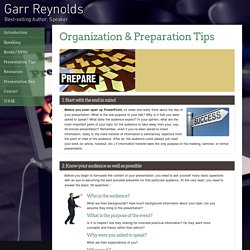

Garr Reynolds Official Site. Structure Your Presentation Like a Story - Nancy Duarte. By Nancy Duarte | 8:00 AM October 31, 2012 After studying hundreds of speeches, I’ve found that the most effective presenters use the same techniques as great storytellers: By reminding people of the status quo and then revealing the path to a better way, they set up a conflict that needs to be resolved.

That tension helps them persuade the audience to adopt a new mindset or behave differently — to move from what is to what could be. And by following Aristotle’s three-part story structure (beginning, middle, end), they create a message that’s easy to digest, remember, and retell. Here’s how it looks when you chart it out: And here’s how to do it in your own presentations. Craft the Beginning Start by describing life as the audience knows it. After you set that baseline of what is, introduce your vision of what could be.
What is: We fell short of our Q3 financial goals partly because we’re understaffed and everyone’s spread too thin. Let’s go back to that Q3 update. Do Your Slides Pass the Glance Test? - Nancy Duarte. By Nancy Duarte | 11:00 AM October 22, 2012 An audience can’t listen to your presentation and read detailed, text-heavy slides at the same time (not without missing key parts of your message, anyway).

So make sure your slides pass what I call the glance test: People should be able to comprehend each one in about three seconds. Think of your slides as billboards. When people drive, they only briefly take their eyes off their main focus — the road — to process billboard information. Similarly, your audience should focus intently on what you’re saying, looking only briefly at your slides when you display them. Keep It Simple Research shows that people learn more effectively from multimedia messages when they’re stripped of extraneous words, graphics, animation, and sounds.
So when adding elements to your slides, have a good reason: Does the audience need to see your logo on each slide to remember who you work for? It’s also important to stick to a consistent visual style in your slide deck. Organization & Preparation Tips. Before you even open up PowerPoint, sit down and really think about the day of your presentation.

What is the real purpose of your talk? Why is it that you were asked to speak? What does the audience expect? In your opinion, what are the most important parts of your topic for the audience to take away from your, say, 50-minute presentation? Remember, even if you’ve been asked to share information, rarely is the mere transfer of information a satisfactory objective from the point of view of the audience. Before you begin to formulate the content of your presentation, you need to ask yourself many basic questions with an eye to becoming the best possible presenter for that particular audience. Who is the audience? What are their backgrounds? What is the purpose of the event? Is it to inspire? Why were you asked to speak? What are their expectations of you? Where is it? Find out everything you can about the location and logistics of the venue. Nancy Duarte: The secret structure of great talks.